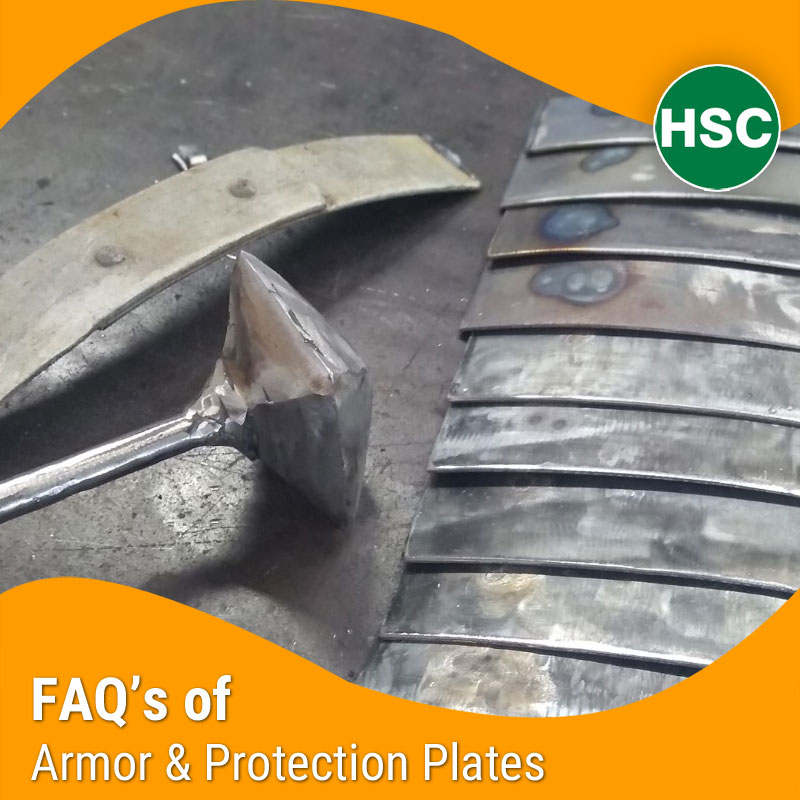One of the most common questions asked by vehicle armorers, defense contractors, and fabricators is:
“Can armor plates be welded or bent without losing their ballistic properties?”
The short answer is yes, but with strict precautions.
At Hindustan Steel Corporation, we supply RHA and HHA plates with clear fabrication guidelines, helping clients weld, cut, and bend armor steel without compromising multi-hit performance or structural integrity.
Welding Armor Plates: Understanding the Challenges
Armor steel plates, especially High Hardness Armor (HHA) grades like HIND ARMOR 500 and HSC 500T, require special welding procedures due to their hardness (470–540 BHN) and quenched and tempered condition.
Key risks include:
- Cracking near the weld zone
- Hardness loss around heat-affected areas
- Reduced ballistic protection if improperly welded
Proper welding technique, preheat temperature, and post-weld stress relieving are essential to avoid failure.
Can Armor Plates Be Bent?
Yes, but bending is thickness-dependent and grade-specific.
| Grade | Bending Behavior |
|---|---|
| RHA (Rolled Homogeneous Armor, ~250–300 BHN) | Easier to bend and form |
| HHA (High Hardness Armor, ~470–540 BHN) | Cold bending possible up to 8 mm; hot forming or modular assembly recommended for thicker sections |
Mechanical Behavior During Welding and Bending
| Property | RHA Plates | HHA Plates |
|---|---|---|
| Ductility | Higher | Lower |
| Crack Resistance | Better | Needs strict welding control |
| Bending Radius | Tighter possible | Larger radius needed |
| Post-Weld Strength | Retained with standard procedure | Needs stress relief for thicker sections |
For both grades, final inspection for cracks and hardness verification is critical post-fabrication.
Standards to Fabrication (H5 to H10)
Welding Standards Applicable to Armor Steel
At Hindustan Steel Corporation, we follow welding guidelines aligned with:
| Standard | Details |
|---|---|
| AWS D1.1 / D1.2 (Structural Welding Codes) | General welding guidelines |
| MIL-DTL-46100 / MIL-DTL-12560 Notes | U.S. military specs with welding notes for armor |
| Client-specific ballistic tender documents | Custom welding procedures for defense projects |
We recommend using qualified welders with experience in armor steel fabrication.
Recommended Plate Thickness for Easier Fabrication
| Fabrication Step | Recommended Thickness |
|---|---|
| Cold Bending | Up to 8 mm for HHA, up to 25 mm for RHA |
| Welding | Any thickness with proper preheat and control |
| Cutting and Drilling | Available for all thicknesses with CNC and coolant-controlled methods |
We offer custom-cut, pre-drilled armor plates to minimize field welding or bending wherever possible.
Preheat and Post-Weld Treatment Guidelines
| Step | HHA Plates | RHA Plates |
|---|---|---|
| Preheat Temperature | 150–250°C | Optional / low heat |
| Interpass Temperature | Maintain below 250°C | Flexible |
| Post-Weld Stress Relief | Recommended for plates >10 mm | Generally not required |
| Welding Electrodes | Low hydrogen (E7018 / E10018) | Standard mild steel electrodes acceptable |
Failure to follow correct procedures on HHA grades can cause micro-cracking and loss of ballistic resistance.
Cutting and Drilling Tips for Armor Steel Plates
| Process | Recommendations |
|---|---|
| Cutting | Use waterjet, laser, or plasma cutting with controlled heat |
| Drilling | Use carbide-tipped tools, low RPM, and coolant flooding |
| Profiling | CNC cutting available for accurate hole layouts and contours |
We also offer pre-cut ballistic door kits, armor panel sets, and OEM vehicle protection layouts.
Why Source Weldable and Bendable Armor Plates from Hindustan Steel Corporation?
- Expertise in armor-grade steel supply
- In-house CNC cutting and drilling services
- Pre-tested, hardness-certified HIND ARMOR 500 and HSC 500T plates
- Pre-fabrication guidance and support for defense contractors
- Fast dispatch for urgent armor projects
- Export-compliant packaging and documentation
We regularly supply OEM vehicle fabricators, infrastructure contractors, and security equipment manufacturers
Popular Armor Grades with Weld and Bend Capability
- HIND ARMOR 500 Plates
- HSC 500T Tactical Grade
- MIL-DTL-46100 Equivalent Plates
- MIL-DTL-12560 RHA Plates
- STANAG 4569 Level Armor Steel
Export Destinations and Packaging for Fabricated Armor Plates
We export pre-cut and pre-drilled armor plates to:
- UAE, Saudi Arabia, South Africa, Germany, Indonesia, Nigeria, and more.
Packaging Includes:
Seaworthy pallets / crates
VCI wrapping
Project-specific labeling
Export documents: MTC, Packing List, Commercial Invoice, Ballistic Test Reports (on request)
Before Welding or Bending Armor Plates
- Confirm plate grade and thickness
- Check project-specific ballistic standards
- Plan fabrication sequence to minimize HAZ (Heat-Affected Zone)
- Consider ordering pre-cut and pre-drilled plates
- Request ballistic test certificates if required for your project
FAQs: Welding and Bending Armor Plates
Can armor steel plates be welded?
Yes, with proper preheating and welding techniques.
Do you need to preheat before welding armor plates?
Yes, especially for HHA grades.
What electrodes are recommended for welding HHA plates?
Low hydrogen electrodes (E7018 / E10018).
Can you cold bend HHA plates?
Yes, but only up to 8 mm thickness
Is post-weld heat treatment necessary?
Yes, for thicker HHA plates
Which is easier to weld: RHA or HHA?
RHA is easier due to lower hardness.
Do you provide welding recommendations?
Yes, as per plate grade and project needs.
What cutting methods work best for armor steel?
Waterjet, plasma, or laser cutting.
Will welding reduce the ballistic properties of the plate?
If not done correctly, yes. Follow controlled welding procedures
What is the delivery time?
5–7 working days for stock thicknesses.
How do I get a quote?
Call, email, or WhatsApp with thickness, grade, and quantity.
Need weldable and bendable armor steel plates for your vehicle armor, ballistic doors, or security projects?
Contact Hindustan Steel Corporation today.
Ask for:
- HIND ARMOR fabrication guidelines
- Pre-cut, pre-drilled plate pricing
- Export packaging details

